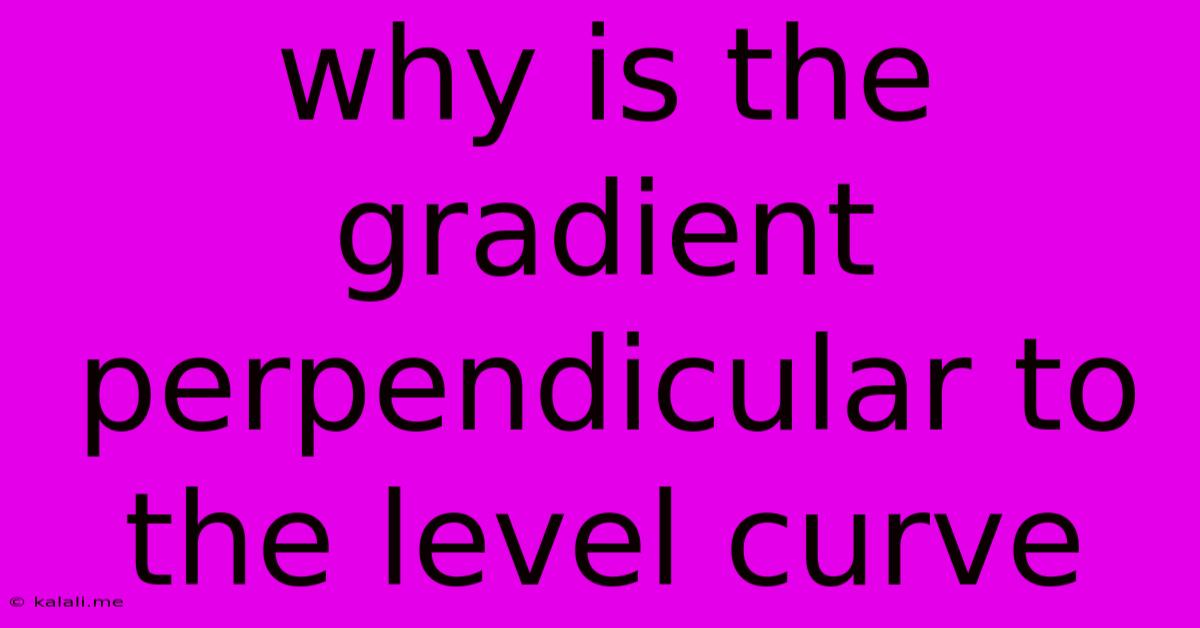Why Is The Gradient Perpendicular To The Level Curve
Kalali
May 31, 2025 · 3 min read

Table of Contents
Why is the Gradient Perpendicular to the Level Curve? A Geometric and Algebraic Explanation
Understanding why the gradient of a function is perpendicular to its level curves is fundamental in multivariable calculus and has significant applications in various fields like physics and machine learning. This article provides both a geometric intuition and a rigorous algebraic proof to solidify this crucial concept. This explanation will cover gradients, level curves, directional derivatives, and the dot product, providing a comprehensive understanding of the relationship.
What are Gradients and Level Curves?
Before diving into the perpendicularity, let's define our key players:
-
Gradient: The gradient of a scalar function f(x, y) (or f(x, y, z) in three dimensions) is a vector field denoted by ∇f. It points in the direction of the greatest rate of increase of the function. For a function of two variables, the gradient is given by: ∇f = (∂f/∂x, ∂f/∂y).
-
Level Curves (or Level Sets): These are curves (or surfaces in 3D) where the function f(x, y) takes on a constant value, say k. That is, the level curve is defined by the equation f(x, y) = k. Imagine contour lines on a topographical map; each line represents a constant elevation.
Geometric Intuition: The Direction of Steepest Ascent
Imagine you're standing on a hill represented by a function f(x, y). The gradient ∇f at your current location points directly uphill – the direction of the steepest ascent. A level curve represents a contour line where the elevation (the function's value) remains constant. To stay at the same elevation, you must walk perpendicular to the direction of steepest ascent (the gradient). Therefore, the gradient must be perpendicular to the level curve.
Algebraic Proof: Using Directional Derivatives and the Dot Product
Let's formalize this intuition with an algebraic proof. Consider a point (x₀, y₀) on a level curve f(x, y) = k. Let v be a tangent vector to the level curve at this point. The directional derivative of f in the direction of v at (x₀, y₀) is given by:
D<sub>v</sub>f(x₀, y₀) = ∇f(x₀, y₀) ⋅ v
Since v is tangent to the level curve, moving along v keeps us on the same level curve, meaning the function's value doesn't change. Therefore, the directional derivative in the direction of v must be zero:
D<sub>v</sub>f(x₀, y₀) = 0
This implies:
∇f(x₀, y₀) ⋅ v = 0
The dot product of two vectors is zero if and only if the vectors are orthogonal (perpendicular). Since v is any tangent vector to the level curve at (x₀, y₀), this proves that the gradient ∇f(x₀, y₀) is perpendicular to every tangent vector of the level curve at that point, and thus perpendicular to the level curve itself.
In Conclusion
The perpendicularity of the gradient to the level curve is a fundamental result that beautifully connects the geometric representation of a function (level curves) with its analytical representation (the gradient). This relationship provides valuable insights into the behavior of functions in multiple dimensions and is instrumental in various advanced mathematical applications. Understanding this concept is key to mastering multivariable calculus and its applications.
Latest Posts
Latest Posts
-
Why Is The Color Running Out Of My Jeans
Jun 02, 2025
-
To Be Young And In Love
Jun 02, 2025
-
How Do I Make Shelf Smaller
Jun 02, 2025
-
How To Stop Facetime From Lowering Volume Mac
Jun 02, 2025
-
What Is The Change Of Getting Quads
Jun 02, 2025
Related Post
Thank you for visiting our website which covers about Why Is The Gradient Perpendicular To The Level Curve . We hope the information provided has been useful to you. Feel free to contact us if you have any questions or need further assistance. See you next time and don't miss to bookmark.